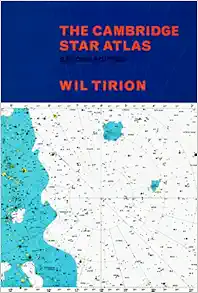
Description
From Booklist Squarely aimed at casual observers, this lovely atlas will also be a useful resource for teachers. Tirion, the author of the highly regarded Sky Atlas 2000.0 and Uranometria 2000.0 , has revised the 1991 edition of the atlas, adding a basic lunar map and guidelines for lunar observation. Information for viewing the sun, planets, or asteroids is not provided. The rest of the material is divided into three sections: monthly sky maps for the northern and southern hemispheres, star charts, and all-sky maps. Each section includes a concise explanation of the astronomy necessary for understanding the maps. Simple instructions are provided for using the monthly maps. These maps, printed in white and yellow on blue, are designed for field use. Charts plot all stars visible to the naked eye in a dark sky. Other objects are selected based on interest and available space. These provide a reasonable survey of galaxies, nebulae, and clusters and include objects only visible with binoculars or small telescopes. There are no detailed descriptions of objects and no distances given, even for selected objects. The all-sky maps use galactic coordinates to show the correlations of various types of clusters, nebulae, and galaxies with the Milky Way's galactic plane. They are particularly delightful because they plainly show which of these objects are galactic in origin and which are extragalactic. All the maps, especially the star charts, are beautifully prepared. Physical quality is also high, and the book is a bargain at $19.95. Strongly recommended for public, high-school, and undergraduate academic libraries. 'Star maps of beauty and clarity are the hallmark of Wil Tirion. Imagine that you are anywhere in the world and want to know what stars are in the sky at any time; then his colourful and handy Cambridge Star Atlas … is the book for you.' New Scientist '[This star atlas] is among the best I have ever used.' Alex Lovell, GNOMON'… a painstakingly produced book … literally opens up a galaxy of information.' Reference Reviews'... excellent value for money'. David Stickland, The Observatory Book Description The one-stop atlas of the sky for beginners everywhere and every night. Read more
Features & Highlights
- The Cambridge Star Atlas covers the entire sky, both northern and southern latitudes, in an attractive format that is suitable for beginners and experienced astronomical observers. There is a series of monthly sky charts, followed by an atlas of the whole sky, arranged in 20 overlapping charts. Each chart shows stars down to magnitude 6.5, together with about 900 non-stellar objects, such as clusters and galaxies, which can be seen with binoculars or a small telescope. There is a comprehensive map of the Moon's surface, showing craters and other named features. Wil Tirion is the world's foremost artist and designer of astronomical maps. For this edition he has devised improved versions of the monthly charts and added all-sky charts, and the text has been completely revised. In this improved and expanded format, The Cambridge Star Atlas is an ideal reference atlas for sky watchers everywhere.





